Methodology Report
#3: Design and Methods of the 1996 MEPS Nursing Home Component
by D.E.B. Potter, M.S.,
Agency for Health Care Policy and Research
Select for more information on
Health Care Information and Electronic Ordering Through the AHRQ Web Site.
Abstract
The Medical Expenditure Panel Survey (MEPS) is
the third in a series of nationally representative surveys
of medical care use and expenditures sponsored by the
Agency for Health Care Policy and Research (AHCPR).
MEPS comprises four component surveys. The Nursing
Home Component (NHC) produces national estimates of
insurance coverage and the use of services, expenditures,
and sources of payment for persons residing in or
admitted to nursing homes. The NHC also gathers
information on nursing home characteristics–such as
facility type, ownership, chain affiliation, certification,
facility size, and location–for a nationally representative
sample of nursing homes. This report describes the
design of and methods used in the MEPS NHC.
Information is included on the NHC objectives, sample
design, instruments of data collection, and data
collection procedures.
Select for information on The Medical Expenditure Panel Survey (MEPS).
Introduction
The 1996 Nursing Home Component
(NHC) of the Medical Expenditure Panel Survey (MEPS) is a national,
year-long, panel survey of nursing homes and their residents. MEPS
is the third in a series of surveys sponsored by the Agency for
Health Care Research and Quality (AHCPR) to collect information
on the health care utilization and expenditures of the American
public. The first survey was the 1977 National Medical Care Expenditure
Survey (NMCES); the second, the 1987 National Medical Expenditure
Survey (NMES). NMES was the first national expenditure survey to
contain an institutional component designed explicitly to collect
medical expenditure information on persons in long-term care facilities.
The 1996 MEPS NHC is cosponsored
by AHCPR and the National Center for Health Statistics (NCHS),
both agencies of the U.S. Public Health Service. Westat, Inc.,
is the prime contractor for data collection and is supported by
MedStat, the National Opinion Research Center, and CODA.
This report describes the design
of and methods used in the MEPS NHC. Information is included on
the NHC objectives, sample design, instruments of data collection,
and data collection procedures. The appendix provides a glossary
of terms and acronyms used in this report and in the MEPS NHC questionnaires.
Note: Earlier versions of this
report were presented at the 1996 Joint Statistical Meetings of
the American Statistical Association, Chicago, August 1996, and
the 1996 annual meeting of the American Public Health Association,
New York, November 1996.
Return To To
Objectives
of the MEPS NHC
The primary objective of the NHC is to estimate
use and expenses for nursing home services and health care for persons
who were nursing home (NH) residents at any time during 1996. Other
major
objectives are to permit estimates of the following measures:
For nursing home residents--
- Annual expenditures and sources of payment
for nursing home services.
- Annual use, expenditures, and sources of payment
for inpatient hospital services.
- Use, expenditures, and sources of payment
for physician services during periods of NH residence.
- Use of prescribed medications.
- Health status at selected points in time.
- Discharge status for residents discharged
during 1996.
- Characteristics of NH residents prior to admission.
- Annual use, expenditures, and sources of payment
stratified by facility and resident characteristics.
For nursing home facilities--
- Facility structure, type of ownership, expenses,
and revenues.
- Services typically provided, staffing, and
numbers of beds and residents.
The MEPS NHC is also designed to permit national
estimates of--
- Number of persons who were NH residents as
of January 1, 1996.
- Number of persons admitted to an NH during
1996.
- Number of persons discharged from an NH during
1996.
- Total NH users for the year.
Return To Top
Sample Design
The MEPS NHC is a year-long panel survey for calendar
year 1996. The design is similar to that of the 1987 NMES Institutional
Population Component survey (Cohen, Potter, and Flyer, 1993) and is
intended to equal or exceed the precision of the 1987 survey. The final
sample design is based on results from the 1987 survey, analyses conducted
during the 1991 NMES Institutional Feasibility Study (Bethel, 1993;
Bethel, Flyer, and Wolters, 1993; Bethel, Ward, and Kalton, 1993),
and work conducted during the pretest
stage of the NHC.
The NHC has a multistage stratified probability
design, with facilities selected in the first stage and residents
in the last stage. The reference population (universe) is all persons
who spent one or more nights in 1996 as a resident of a nursing
home. To allow a chance of selection for all persons in this universe,
two samples of residents were selected within sampled cooperating
facilities:
- A cross-sectional sample of January 1, 1996,
residents (referred to as January 1st residents or current residents).
- A sample of persons admitted during 1996,
with no prior admissions during 1996 to a facility eligible for
the NHC (referred to as first admissions).
Thus, all persons who were residents of an
NH any time during 1996 were represented in the sample.
Facility Eligibility
The universe of institutions eligible for inclusion
in the MEPS NHC consisted solely of nursing homes, whereas the 1987
institutional survey also included personal care homes and facilities
for persons with mental retardation. For a discussion of why these
facility
types were excluded from MEPS, see Sommers (1995).
To be included as a nursing home, a facility
must have met one of the following definitions:
- A facility or distinct portion of a facility
certified as a Medicare skilled nursing facility (SNF).
- A facility or distinct portion of a facility
certified as a Medicaid nursing facility (NF).
- A facility or distinct portion of a facility
licensed as a nursing home with three or more beds that provides
onsite supervision by a registered nurse (RN) or licensed practical
nurse (LPN) 24 hours a day, 7 days a week.
By these definitions, all SNF- or NF-certified
units of licensed hospitals were eligible for the sample, as were
all Department of Veterans Affairs (VA) long-term care nursing
units. In such cases, and in the case of retirement communities
with nursing facilities, only the long-term care nursing unit(s)
of the facility were eligible for addition to the sample. If a
facility also contained a long-term care unit that provided assistance
only with activities of daily living (e.g., a personal care unit)
or provided nursing care at a level below that required to be classified
as a nursing facility, that unit was excluded from the sample.
(For operational details on how this was accomplished, see information
in this report on the Round 1 Facility-Level Data.)
Sample Frame
The cleaned (unduplicated) list of eligible facilities
from the 1991 National Health Provider Inventory (NHPI) served as the
starting point for frame construction (Sirrocco, 1994). NCHS updated
the NHPI with lists of facilities that were licensed by the States
or certified by the Health Care Financing Administration (HCFA). New
facilities (births to the frame) were determined by NCHS and AHCPR
staff, who compared the updated list with the 1991 NHPI. To ensure
that the updated list had no duplicate listings, comparisons were made
of facility name, address, phone number, and
size (Sommers, 1995).
Additionally, efforts were made to add hospital-based
long-term care (LTC) units to the frame. LTC units have grown considerably
in the last few years (Prospective Payment Assessment Commission,
1996). The American Hospital Association's listing of hospitals
was carefully reviewed. Any hospital-based LTC units not on the
updated NHPI, including VA nursing homes, were added. As a result,
275 facilities were added, representing 13 percent of the hospital-based
NHs in the frame. The updated list consisted of 17,572 nursing
facilities containing 1,789,772 beds, an increase of 2,641 facilities
and 174,086 beds over the 1991 NHPI (Table 1).
Key information required for sampling, such
as number of nursing home beds, was available for 15,581 of the
17,572 facilities in the final NHC frame. By searching directories
and lists of NHs, NCHS and AHCPR staff found missing bed-size information
for all but 100 facilities. Bed size was imputed for these facilities.
A somewhat larger number of facilities had missing information
on other variables needed for sampling, such as ownership. However,
it was felt that this amount of missing information was insignificant
(Sommers, 1995). Thus, to save resources, AHCPR did not update
frame information any further.
The final numbers of NHs and NH beds in the
NHC frame were compared with an independent source (Harrington,
Preston, Grant, et al., 1990) and found to be well within range
(Sommers, 1995). Additional information is available on the use
of the 1991 NHPI as a sampling frame (Sommers, 1993) and frame
construction for the MEPS NHC (Sommers, 1995).
Sample Selection
A stratified two-stage systematic sample was adopted,
where stage 1 reflected the selection of facilities (in two phases)
and stage 2 reflected the selection of persons in these facilities.
For complete technical details, see Bethel, Broene, and Sommers (1998),
Sommers (1995), and Sommers, Bethel, and Broene (forthcoming).
First-Phase Facility Selection
Facilities were selected in the first phase with
selection probabilities proportional to the number of nursing home
beds in the facility. Allocation was proportional to the total number
of beds in the stratum. The primary stratification was by method of
Medicaid reimbursement and type of nursing facility. Within the primary
strata, location variables of the NH and type of ownership were used
for implicit stratification.
As part of this phase, a Keyfitz procedure
was used to adjust the probabilities of selection to eliminate
any overlap between the 1996 MEPS NHC facility sample and the sample
for the 1995 NCHS National Nursing Home Survey. This adjustment
was made to reduce the burden on nursing home respondents (Sommers,
1995). By this methodology, 1,651 facilities were selected in the
first phase of facility selection.
Second-Phase Facility Selection
The initial sample of facilities was selected in
order to achieve a second-phase sample of 1,150 facilities. Results
from the 1987 survey (Cohen, Potter, and Flyer, 1993) and the 1991
feasibility study (Bethel, Ward, and Kalton, 1993) indicated that survey
data collection costs could be reduced, while minimizing the effect
on variance, by subsampling facilities in the higher cost strata at
rates of selection lower than the rates for those in the less expensive
strata.
To subsample the facilities, those sampled
in the first phase were assigned to cost strata based on interviewer
travel and workload costs using computerized mapping software.
Table 2 shows the cost strata. Once the facilities were assigned,
each cost stratum was subsampled using Cochran's (1977) optimal
allocation technique.
Table 2 shows the distribution of the first-phase
sample of facilities by cost strata. It also shows the results
for the second phase of facility subsampling by cost strata, resulting
in the final facility sample of 1,150.
Person-Level Sample Selection
To assure representation of all persons who resided
in the nursing home during the study period, two types of person samples
were
selected in the sampled cooperating facilities:
- Current residents--Persons admitted to a sampled
facility before January 1, 1996, who were not discharged as of
January 1, 1996 (i.e., the cross-sectional sample of January
1st residents).
- First admissions--Persons admitted to the
sampled facility on January 1 or later during 1996 who had no
earlier 1996 admission to any eligible facility.
Sample of Residents. A fixed sample of four
January 1st residents was selected in each cooperating sampled
facility during Round 1. The January 1st sample of residents was
selected by interviewers from a frame constructed by the interviewer
or from a frame provided by the facility. Interviewers cleaned
and numbered the list of residents and then selected a random sample
of four residents by entering the number of eligible residents
in the facility into the interviewer's laptop computer. (Residents
were eligible if they resided in an eligible long-term care unit
of the sampled facility as of midnight December 31, 1995.) The
computer then listed the line numbers for the random sample selected.
The cross-sectional sample of all January 1st residents is expected
to yield 3,344 residents at the end of Round 1 and 3,144 with expenditure
data at the end of Round 3 (Table 3).
Sample of Admissions. To obtain a sample of
eligible first admissions, a sample of two persons was selected
from a list of first admissions at each of the sampled cooperating
facilities in Rounds 2 and 3. In a few facilities with large admissions
populations, the sample could be three persons per round, for a
maximum of six 1996 admissions sampled per facility.
The Round 2 frame consisted of all persons
whose first stay in the facility during 1996 resulted from an admission
during the period January 1, 1996, through June 30, 1996. The Round
3 frame consisted of persons admitted to the sampled facility during
the July 1-December 31, 1996, period who had no prior admissions
to the sampled facility during 1996. The interviewer's procedures
for selecting the admissions sample are analogous to those used
for the January 1st sample.
To ensure that each person sampled as an admission
had a single chance of selection, information about where the person
resided between January 1, 1996, and the date of admission to the
sampled facility was collected from facility and community respondents.
All places identified by respondents as a long-term care place
were searched on the sampling frame directory for determination
as an eligible NH. Persons sampled as an admission who had a January
1, 1996, stay or 1996 admission to an eligible NH prior to their
admission to the sampled NH were not eligible for the MEPS NHC,
as they had a prior chance of selection. These procedures were
first tested in the 1991 feasibility study (Bethel, Flyer, and
Wolters, 1993). Subsequent data collection on these ineligible
persons was terminated. This exclusion of ineligible admissions
is expected to result in a final admissions sample of 2,344 persons
with expenditure data at the end of Round 3.
Subsampling the Sample of Facilities and Persons
The response rate assumptions used to develop the
projected sample sizes presented in Table 3 were designed to result
in a final facility sample size of 787 cooperating facilities at the
end of 3 rounds of data collection. At the end of Round 1 data collection,
1,127 of the 1,150 sampled facilities were determined to be eligible;
952 of these were eligible and responding (85 percent). To bring the
sample size in line with the original design, the facility sample was
subsampled at the end of Round 1. A total of 127 facilities (and all
sampled persons in those facilities) were randomly deselected. Of these
facilities, 108 cooperated in Round
1.
Return To Top
Instruments
and Data Collection Procedures
The data collection methods of the MEPS NHC are
products of those used for the 1987 NMES institutional expenditure
survey (Edwards and Edwards, 1989), the 1991 institutional feasibility
study (e.g., Anderson, Harper, Tourangeau, et al., 1993), and NHC pretest
work. While the 1996 methods are similar to those used in 1987, several
enhancements have been introduced for three principal reasons:
- The analytic desirability of quantifying recent
changes in the NH industry--most importantly, the diversification
of services provided and the debundling of payments for NH services.
- The change in mode of data collection from
a paper-and-pencil mode to computer-assisted personal interviewing
(CAPI).
- Improvement in data quality and/or reduction
in data collection costs. (For example, see Anderson, Bethel,
Tourangeau, et al., 1994; Potter, 1988; Potter and Braden, 1993.)
The MEPS NHC questionnaires are available on
the MEPS home page at the AHCPR Web site, ../default.htm, or through
the AHCPR Clearinghouse (call 301-594-1406 for ordering information).
Overview of Data Collection Methods
Table 4 presents an overview of the data collection
plan for the MEPS NHC. The plan calls for a Screener/Recruitment Round
and three rounds of data collection. The Screener/Recruitment Round
is conducted by telephone to recruit the facility's participation in
the study. Rounds 1-3 are conducted in the nursing home using CAPI
technology. There is also a single telephone interview with a community
respondent knowledgeable about the sampled person's situation prior
to admission to the NH; this interview is conducted in Round 2 (or
Round 3 if sampled in Round 3).
Round 1
Round 1 consists of a visit by an interviewer to
the sampled nursing facility to collect facility and sampled person
data. The interviewer administers the Facility Questionnaire, which
collects information on the characteristics and structure of the facility,
and determines the facility's final eligibility for the NHC. Once the
Facility Questionnaire is completed and the facility (or any part of
the facility) is determined to be eligible, the interviewer constructs
a sampling list of January 1, 1996, residents in eligible parts of
the facility, selects a random sample of four, and begins person-level
data collection.
Round 1 data collection for the January 1st
resident sample consists of residence history information (including
hospital stays) from the date of last residence in the community
until the date of the Round 1 interview; health status; demographics
and background; insurance information; and prescription medicine
use.
Round 2
In Round 2, interviewers return to the sampled
facility and continue data collection on the facility by updating facility
certification information and enumerating the services routinely provided
by the facility. Interviewers also continue data collection on the
January 1st sample of residents by updating their residence history
and collecting information on health service use, prescribed medicine
use, NH expenditures, and incident health conditions (e.g., acute conditions
occurring during NH stays). This information is collected for periods
of NH residence during the period from January 1st to the date of interview.
Interviewers also identified potential respondents for community data
collection.
In Round 2, interviewers select a sample of
residents who were admitted to the sampled nursing home between
January 1 and June 30, 1996 (the first of two samples of admissions).
Data collected include residence history information from January
1 (or date of last community residence if prior to January 1) until
the date of the Round 2 interview; health status information, demographic
background, and insurance coverage at the time of admission to
the nursing home; and health service use, prescribed medicine use,
and NH expenditures during periods of institutionalization. Potential
community respondents are also identified.
Community data collection for persons sampled
as January 1st residents and for the Round 2 sample of admissions
is begun in Round 2. The same interviewers who conducted the facility
interview generally conduct the community interview about each
sampled person by telephone from the interviewer's home using computer-assisted
interviewing (CAI) technology. The Community Questionnaire collects
information for which the nursing home is not a good source of
information, such as family relationships (Tourangeau and Blair,
1993). It also collects key information asked during the facility
interview but not available from that source, as well as income,
assets, and caregiving data.
New facility data collection is also initiated
in Round 2. The design of the NHC is such that sampled persons
are followed as they move from one eligible facility to another
eligible facility. This provides a picture of an entire year's
worth of use and expenditures in all nursing homes in which the
person was a resident during 1996. For all persons discharged from
the originally sampled nursing home during the Round 1 reference
period and admitted to another potentially eligible nursing home,
Round 2 data collection in the new (transfer) facility is initiated.
Data collection begins at the new facility
with administration of the New Facility Questionnaire, which determines
the facility's eligibility and mirrors the Round 1 sampled Facility
Questionnaire. Person-level data collection in a new facility is
similar to Round 2 data collection in a sampled facility.
Round 3
Round 3 continues data collection on the sampled
facility by gathering information on patient revenues and expenses
in the facility and updating facility staffing information that was
originally collected in Round 1. Resident information about residence
history, health status, health services use, expenditures, and prescribed
medicine use is updated. Health status information as of December 31
is collected for the January
1st sample still in a nursing home.
During Round 3, interviewers select a sample
of admissions from residents who were admitted to the sampled facility
between July 1 and December 31, 1996, and who were not admitted
to the NH previously during 1996. The same data are collected on
this sample as for the Round 2 sample of admissions.
New facility data collection continues in Round
3.
Instruments and Data Items
Data collection for the MEPS NHC was preceded by
almost 2 years of instrument design work, including feasibility testing
and usability testing. This work, in conjunction with previous research
(e.g., Anderson, Bethel, Tourangeau, et al., 1994; Anderson, Harper,
Tourangeau, et al., 1993; Northrup and Ward, 1993; Potter and Cunningham,
1994; Tourangeau and Johnson, 1993; Tourangeau, Vincent, Anderson,
et al., 1993), led to an instrument that uses CAPI technology almost
exclusively.
Aside from the intent of improving data quality,
the NHC CAPI instrument was designed to take advantage of the CAPI
computer environment in several ways, including:
- Determining the "best respondent" for
the interviewer at the item level rather than at the questionnaire
level or respondent level.
- Prompting the interviewer to retrieve missing
data items from alternative respondents before leaving the NH.
- Prompting the interviewer to reconcile inconsistent
data (as determined by mathematical formulas) with the respondent
at the time of data collection.
- Providing the interviewer with preloaded directories
of information (e.g., prescribed medicine data) to be used during
data collection.
- Reducing respondent burden in the NH by organizing
data collection around the respondent.
Conducting the NHC in CAPI can have other advantages
as well, including shorter post-production processing time and
subsequent data release to the public. However, using CAPI in a
survey such as the NHC can have a downside in that the resulting
instruments, with their numerous flow boxes, programmer specifications,
and question word fills, can be difficult to comprehend. The purpose
of this section of the report is to overcome the natural limitations
of reading a complicated CAPI questionnaire by providing the reader
with the analytic intent of each of the questionnaire sections.
Also presented is an overview of key data collection methods. The
section is in four parts:
- Facility-level data collection in the sampled
NH.
- Person-level data collection in the sampled
NH.
- Person-level data collection in the community.
- Data collection in the transfer (new) facilities.
Facility-Level
Data, Sampled NH
Screener/Recruitment Materials. The telephone screener/recruitment
round is conducted using scripted materials. The purpose is to verify
the facility's name and address, screen out facilities that are clearly
ineligible (e.g., facilities with no nursing staff), recruit the facility
to participate in the survey, and make an appointment for the Round
1 interview.
Round 1 Facility-Level Data. The Round 1 facility-level
data collection consists of administering the Round 1 Facility
Questionnaire (FQ), distributing and collecting the Round 1 Self-Administered
Questionnaire (SAQ), and collecting the facility's printed rate
schedule. The Round 1 FQ is a CAPI instrument that is administered
in person to the facility administrator (or designee). It must
be administered before any person-level data collection can begin.
The FQ is divided into five parts, each uniquely identified in
CAPI by letter identifiers. The letter identifiers and their descriptions
are as follows:
| FA |
Facility structure and characteristics:
This section maps how the sampled facility is structured (explained
below), determines the facility's final eligibility for the
survey, and collects data on facility characteristics. A mechanism
for collecting the Round 1 SAQ is included at the end. |
| FR |
This section is a mechanism for collecting
a copy of the facility's printed rate schedule. |
FG |
Facility records organization grid: This section
includes prompts to identify the various records containing resident
data that the facility maintains, and to obtain access to the records
and to the facility staff members in charge of the records. |
| SS |
Sampling section: This section is used for selecting
a sample of four January 1st residents. The "Call Home Office" function,
related to this section, is a mechanism for interviewers to alert NHC
statisticians, in real time, to problems with the measure of size and
dual probabilities of facility selection, among other functions. Once
the sample of residents is selected, the sampling section collects person-level
information--name, age, sex, date of admission, and date of death (if
applicable)--necessary to set up the question word fills in the subsequent
person-level instruments. |
| MD |
Missing data module: If certain critical facility
items are missing (e.g., information needed to determine the facility's
eligibility), this module presents the items for another respondent (in
the same NH) to answer. |
See Table 5 for a listing of the major data
items in the Round 1 FQ.
The Round 1 Self-Administered Questionnaire
is distributed to the facility administrator (or designee) during
the administration of the Round 1 FQ. The SAQ collects information
that the pretest showed could not be easily collected by in-person
interviewing (mostly staffing information). See Table 5 for a description
of the data items.
Facility Structure and Place Type. The
structure of some institutions that provide residential treatment
continues
to become increasingly complex. The Round 1 Facility Questionnaire
was designed to elicit this complexity. Some nursing homes exist
within a larger establishment (e.g., a retirement center or hospital).
In such cases, the entity that appeared on our sampling frame might
be the larger facility, the nursing home within a larger facility,
or only one of several units within the larger facility. Therefore,
the Round 1 FQ was designed to identify all parts of the larger
facility, the nursing home within the larger establishment, and
all units within the nursing home (including special care units
such as Alzheimer's units), as well as enumerating all other nonhospital
residential parts such as assisted living complexes, personal care
units, and independent living facilities. All places where persons
sleep overnight (and on the same campus as the NH) were enumerated
by name, type, bed size, and survey eligibility. To make this workable
within an interviewing environment, the CAPI application used specific
name fills. For example, when a question referred to the larger
entity, the question shown on the interviewer's laptop computer
displayed the appropriate name of the larger establishment. When
a question referred to only the eligible nursing home/unit within
the larger configuration, then the name of each eligible nursing
home/unit was displayed. Based on the enumerated information, the
Round 1 CAPI application assigned a "place type" taxonomy
to each and every part of the facility. Possible place types are:
- Eligible long-term care (e.g., nursing home).
- Ineligible long-term care (e.g., personal
care unit).
- Hospital.
- Community.
An eligible long-term care place is defined
as a facility or distinct part of a facility certified by Medicare
or Medicaid or licensed as a nursing home with three or more beds
that provides onsite supervision by an RN or LPN, 7 days a week,
24 hours a day. An ineligible long-term care place is a facility
or distinct part of a facility that is not certified or licensed
as an eligible nursing home but provides services for personal
care assistance with bathing or dressing. These include residential
care places, board and care homes, personal care homes, assisted
living facilities, and similar units of retirement centers or nursing
homes. Hospitals could be acute or long-term care (LTC) hospitals.
In the case of a hospital with a skilled nursing (SNF) unit or
an eligible LTC unit, the SNF/LTC unit was classified as an eligible
LTC place and the remaining hospital units classified as appropriate
(e.g., hospital). Community places include all independent living
units of retirement centers, as well as private homes or apartments.
The NH structure/place type information--known
collectively as the Place Roster--is important for two reasons.
First, analytically, it is the mechanism by which basic characteristics
of the NH are enumerated. Second, operationally, it is used by
the CAPI software to drive subsequent skip patterns and word fills
in the Round 1 Facility Questionnaire and in all person-level instruments.
(See section on person-level data below.) A fictitious example
of how a Place Roster might look on the interviewer's laptop at
the end of the Round 1 Facility Questionnaire is shown below.
In this case, the larger facility is the Jordan
Senior Living Center, which has three parts: an independent living
building (Horizon House), an assisted living building (Naomi House),
and a nursing home (Johnson Health Center). The nursing home (eligible
LTC) contains three parts: an Alzheimer's unit and two general
population nursing wings (the East and West Wings). In this example,
NH expenditure data would be collected for sampled person stays
in any part of the Johnson Health Center but would not be collected
for sampled person stays that occurred in the Horizon House or
Naomi House.
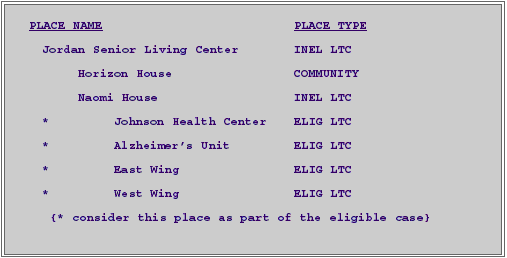
Round 2 Facility-Level Data. The Round 2 instruments
on the sampled facility level consist of:
- Round 2 Facility Questionnaire.
- Round 2 Sampling Instrument.
- Facility Rate Schedule Form.
In addition, any Round 1 SAQs not collected
previously are collected in Round 2.
The Round 2 FQ is a CAPI instrument administered
to the facility administrator. The majority of the data items are
on services routinely offered by the facility to residents and
nonresidents (Table 5). The instrument also collects information
about physicians with NH staff privileges. This information has
both analytic and operational relevance. Operationally, this information
is used to differentiate physicians whose services are billed for
through the NH, as part of the NH's basic room and board rate,
from those physicians who bill the NH separately for their services
(i.e., services that might subsequently result in Medicare Part
B claims). Unlike the Round 1 FQ, the Round 2 FQ does not have
to be administered prior to Round 2 person data collection.
The Round 2 Sampling Instrument is used to
select the first sample of admissions (two persons on average,
with a maximum of three). To eliminate persons with a dual probability
of selection, persons residing in the NH on January 1st are not
eligible for Round 2 admissions sampling. Otherwise, the instrument
is similar to the Round 1 sampling instrument.
The Facility Rate Schedule Form is a paper
instrument uniquely generated by the data collection contractor
for each facility. It retrieves missing rate schedule information
not collected in Round 1, as well as collecting billing rates for
basic care provided in each special care unit within the facility
and for HMO (health maintenance organization) contract care.
Round 3 Facility-Level Data. The Round 3 facility-level
instruments consist of:
- Round 3 Facility Questionnaire.
- Round 3 Sampling Instrument.
- Round 3 Self-Administered Questionnaire.
The Round 3 FQ is a CAPI and/or paper instrument,
depending on the availability of the respondent and applicable
records. Known as the Cost-of-Patient-Care Questionnaire (CPCQ),
its main purpose is to collect patient revenue and expense data
on the NH. ( See Table 5 for details.) NH administrators are the
most likely respondents. They are urged to consult the facility's
Medicaid Cost Reports and/or annual report when answering the questions.
The Round 3 Sampling Instrument is similar
to the one used in Round 2 (two admissions sampled on average),
except that the sampling frame is constructed from a list of persons
admitted to the NH from July 1 to December 31, 1996. Persons residing
in the sampled NH on January 1 or admitted to the facility between
January 1 and June 30, 1996, are not eligible for Round 3 admissions
sampling, as they had a prior chance of selection.
The Round 3 SAQ is also known as the Round
3 NH Staffing Questionnaire. It is similar in design to the Round
1 SAQ, except that data are collected as of the end of the year
and items on NH staff turnover and physicians' privileges in the
NH have been added (Table 5).
Person-Level
Data, Sampled NH
Previous research showed that multiple respondents
within a single NH would be needed for sampled person data collection
(Anderson, Bethel, Tourangeau, et al., 1994). This need arose partly
because of the wide variety of organizational structures and medical
record storage locations among NHs and partly because of the demanding
schedules of nursing home staff. Therefore, the NH CAPI application
was designed with seven topical modules to accommodate multiple respondents,
NH staff, and records availability. These
topical sections are:
- Residence History.
- Health Status.
- Background.
- Insurance.
- Prescribed Medicines.
- NH Expenditures.
- Health Services Use.
At the time of data collection, the interviewer
determines the order in which the topical sections are administered,
based on availability of staff and medical records. The one exception
is the Residence History section, which sets up a person's reference
dates; it must be administered prior to other sections for each
person.
Interviewers select a sampled person and associated
topical section with the use of a specially designed CAPI person-level
screen used for navigation, which displays a grid with the names
of the sampled persons for a particular NH down the left side,
defining rows, and displays abbreviated topical section names across
the top, as column heads (Figure 1). When using the navigation
screen, interviewers use the arrow keys of the laptop to move the
cursor around the cells of the grid, pressing the enter key to
bring up a program section for a sampled person. (For more details,
see Sperry, Edwards, Dulaney, et al., forthcoming.) Whether a topical
section needs to be administered during a round is determined by
numerous MEPS NHC design criteria, including when the sampled person
was sampled, the round of data collection, where the sampled person
moved to during the round (and in some cases the previous round),
the sampled person's vital status and date of death, and, in some
instances, the availability of key data items. These specifications
are programmed as part of the CAPI application. (See MEPS NHC Navigation
Specifications for details. The Navigation Specifications are part
of the MEPS NHC questionnaires and are available on the MEPS home
page at the AHCPR Web site, ../default.htm.) An overview of the
design by topical section and round is shown in Table 4.
Return To Top
The NHC CAPI questionnaire makes numerous references
to four types of sampled persons. These person types (Figure 2)
are defined each round, using information collected with the Residence
History questionnaire section. They are used to define question
skip patterns in the subsequent person-level questionnaire sections.

Return To Top
The following sections detail the data collection
methodology and the major data elements contained in the seven
person-level topical sections of the NH CAPI application.
Residence History. The Residence History (RH)
section is administered in the sampled facility during the round
in which the sampled person was first sampled and in every round
thereafter. Data are typically collected from respondents using
medical records and admissions and discharge documents. The RH
section has three major purposes:
- To determine the whereabouts of the sampled
person each day of the 1996 reference period. This includes identifying
such things as NH admission/discharge dates, place of residence
prior to NH admission (or after discharge), date of last community
residence, and date of death.
- To drive data collection for all the other
person-level sections. For example, NH admission and discharge
dates (during 1996) determine the reference periods for prescribed
medicine use data collection.
- To determine the survey eligibility of persons
sampled for addition to the survey. (For example, persons with
a prior probability of selection are ineligible.)
As noted previously, the RH instrument must
be administered before any other person-level questionnaire section
in order to establish each person's reference dates. The section
collects information about all stays of one or more nights. These
include, for example, inpatient hospital stays; stays in the community,
in the sampled person's own residence, personal care places, or
in other nursing homes; and stays in the sampled NH. Other RH data
items include dates of the stay and stay type. Also identified
is the specific unit in which the NH stay occurred, in situations
where the NH (or the larger configuration of the NH) has multiple
units. Table 6 provides an overview of the RH data items.
Return To Top
All stays identified as part of RH data collection
are classified into one of four stay types. The criteria for stay
type determination are programmed into the CAPI RH application
and are used to define stays in eligible nursing units. Since a
place can have multiple units with distinctly different place types,
the RH questionnaire classifies both places and stays, as follows:
- Eligible long-term care.
- Ineligible long-term care.
- Hospital.
- Community.
The definitions of these place/stay types match
those described earlier. (See Facility Structure and Place Type.)
Depending on the place type, additional information about the stay
and the place where the stay occurred can be collected. For example,
for stays in the community, information is collected about the
person(s) with whom the sampled person lived (Table 6).
Several key dates are determined by the RH
CAPI application and then used to steer person-level data collection
within a round and across rounds. In addition to such information
as NH admission and discharge dates and date of death, these key
analytic dates include:
- Sampled Admission Date (SAD)--For January
1st residents (current residents), the date of the most recent
admission to the sampled facility prior to January 1, 1996. For
persons sampled as first admissions, the date of the first admission
to the sampled facility during the reference year (January 1-December
31, 1996).
- Key Admission Date (KAD)--The beginning of
the episode of sampled nursing home care. The date of the first
admission to the sampled facility, excluding readmissions following
an acute care hospital stay.
- In scope Admission Date (IAD)--The beginning
of the episode of eligible nursing home care. The date of the
first admission to an eligible nursing facility, excluding readmissions
following an acute care hospital stay.
- Transfer Admission Date (TAD)--The date of
admission to an eligible facility, either sampled or new, by
a sampled person who transfers out of the originally sampled
NH to another NH during the reference year, as reported by the
transfer facility.
- End Date for Earliest Community Stay (CED)--The
date of the beginning of the episode of institutionalization
(regardless of whether the stay was in an eligible nursing home
or an ineligible long-term care place), excluding readmissions
following an acute care hospital stay. The end date of the most
recent time the sampled person lived in the community.
Return To Top
One other key date is used for person-level
data collection. This date is not established in the RH but in
the Background Questionnaire section. It is defined here for completeness:
First Long-Term Care Use (FLU)--The date of
first ever long-term care use in a person's lifetime.
Examples of these key dates for a few fictitious
sampled persons are illustrated in Figure 3. It is possible for
all these dates to be the same for a person, for all the dates
to be different, or something in between.
Return To Top

Return To Top
The RH section is also used to determine person-level
eligibility. Persons sampled as an admission who have a prior 1996
admission to an eligible NH, or who were resident in an NH on January
1, 1996, are ineligible for the survey. Determination of eligibility
is made by CAPI using RH data and a preloaded directory of the
sampling frame. This methodology was first tested in the 1991 feasibility
study (Anderson, Bethel, Tourangeau, et al., 1994; Bethel, Flyer,
and Wolters, 1993). Persons classified as an ineligible first admission
are ineligible for subsequent data collection. Sampled admissions
can also be classified as ineligible using residence history data
collected from community respondents. (See Person-Level Data, Community.)
Health Status. Health status
data collected in the facility are measured at multiple time points,
depending on the data item and whether the person was sampled as
a January 1st resident or as an admission. The following time points
are possible:
- January 1, 1996--Used to collect baseline
health status information for persons sampled as January 1st
residents. These data are collected during Round 1.
- December 31, 1996--Used to collect
end-of-year health status information for persons sampled as
January 1st residents and still in an eligible nursing facility
on December 31. These data are collected during Round 3.
- Key Admission Date (KAD)--Used to collect
baseline health status information for persons sampled as an
admission. For most admissions, the KAD is the first admission
in 1996 to the sampled NH. (However, if a person were admitted
to the sampled NH from the hospital following a stay that began
before 1996 and had been a resident of the sampled NH immediately
prior to the hospital stay, the KAD would be the date the person
was first admitted to the sampled NH, which would be prior to
1996.) For the Round 2 sample of admissions, these health status
data are collected during Round 2; for the Round 3 sample of
admissions, these data are collected during Round 3.
- KAD plus 90 days--Used to collect health
status data a second time for persons sampled as an admission
(provided that the person is still in an eligible nursing home).
These data can be collected in either Round 2 or 3, depending
on when the 90-day point occurs. When the 90-day point occurs
during 1997, data collection is still attempted, provided the
person is in an eligible NH unit.
- All of 1996--Used to ascertain incident
infections during periods of NH residence. These data are collected
each round that a sampled person resided in an eligible NH unit.
Return To Top
The facility Health Status section is designed
to accommodate all of these time points. (See Table 7.)
Most of the health status items collected in
the NH are based on the Resident Assessment Form of the Health
Care Financing Administration (HCFA), known as the minimum data
set (MDS). (The address of the MDS 2.0 information site on the
World Wide Web is http://www.hcfa.gov/Medicare/MdS204/default.ntm.)
The CAPI application collects the MDS information in a question
format (Figure 4, top screen), with question wording, response
categories, and definitions of concepts derived directly from the
MDS. This design permits the interviewer to abstract health status
data directly from MDS forms, and also provides a questionnaire
mechanism to collect data for persons with no MDS forms. Definitions
of the possible response categories (e.g., what does "occasionally
incontinent" mean?) were derived from the MDS and were provided
to interviewers as part of the CAPI online help system, which the
interviewer could access with a laptop function key (Figure 4,
bottom screen).
Return To Top

There are multiple versions of the MDS. MEPS
health status questions (to be obtained in the NH) were based on
question wording in Version 2 of the MDS. Version 2 has more detail
than Version 1 and was the HCFA standard for 1996.
There are also multiple reasons for an MDS
assessment (e.g., annual review, quarterly review), and different
MDS forms are used for different assessment reasons. MDS forms
can also vary by State (e.g., because of waivers). As a result,
not all MDS health status items are located on all MDS forms. In
order to accommodate this variation in the MDS, Westat, the data
collection contractor, surveyed all States as to their use of MDS
forms (Hallman, 1995). Copies of all the State forms were collected
and reviewed, and this variation was built into the health status
CAPI programming. CAPI determines for the interviewer which MDS
forms (e.g., annual, quarterly) and which section of the MDS the
respondent (and interviewer) should be using to obtain the correct
information (Figure 4). Health status items not based on the MDS
are labeled as such so that interviewers can cue the respondent
to check medical records to obtain the information (Figure 5).
Table 7 indicates the NHC health status items and whether the MDS
question wording is the basis of the item.
Return To Top

Return To Top
Health status data are collected each round.
These data are abstracted from NH medical records and MDS forms,
or collected by interviewing respondents (typically nursing staff),
who refer to records during the interview.
Background and Insurance. The
design of the 1987 institutional survey was such that many of the
demographic data items for sampled persons were collected from
both next-of-kin residing in the community and from NH respondents.
This resulted in some redundancy and inconsistency in the data
and increased the data collection costs. Because of these problems,
as well as the questionnaire and item nonresponse associated with
community data collection in 1987, AHCPR undertook a series of
analyses to investigate alternative data collection methodologies
for background data items (Anderson, Bethel, Tourangeau, et al.,
1994; Tourangeau and Blair, 1993; Tourangeau and Johnson, 1993).
The design for the MEPS NHC Background and Insurance sections is
a direct outgrowth of those analyses. The analyses indicated, in
part, that:
- Some demographic data items could be collected
from either facility respondents or community respondents with
no loss in the reliability of the data.
- Some data items were best collected from community
respondents.
- Background item nonresponse could be reduced,
with no sacrifice in reliability, by collecting some items from
the facility rather than from the community.
This led to an NHC design based on the premise
that a "best" respondent could be identified for a data
item, considering simultaneously data quality issues, respondent
burden, and data collection costs. Thus, each demographic
item is collected by one of the following five methodologies:
- Facility is the only data source for the item.
- Facility is considered the primary data source
for the item. If the facility is unable to provide the information
for a person, it is subsequently collected from the person's
next-of-kin residing in the community.
- Community is the only data source for the
item.
- Community is considered the primary data source
for the item. For operational reasons, the data are collected
from both the community and facility.
- Item is collected from both community and
facility. The NHC design assumes no primary data source for the
item.
Since the methodology is driven, in part, by
the completeness of the data provided, it may vary across persons.
Table 8 shows the data items by the methodology used. Excluded
from this table are community-respondent-reported items on potential
caregiver network, caregiver services, and health status data for
the period prior to admission; these data are collected only from
community respondents. See Person-Level Data, Community, for additional
information on these items.
Return To Top
The facility Background (BQ) and facility Insurance
(IN) sections are used to collect demographic items from respondents
and records within the sampled NH. The Background section collects
demographic information, typically from nursing staff who use medical
records. The Insurance section collects data on a person's insurance
coverage at baseline. For January 1st residents, this is January
1, 1996. For persons sampled as admissions, this is the time of
admission to the sampled NH (KAD). For January 1st residents, a
few items on insurance coverage are also collected for the time
of first admission to the NH (KAD). These data may be collected
from respondents who use medical records (including MDS forms)
but may also be collected from sources in the NH's billing office.
The Background and Insurance sections are administered just once
per person during the round in which the person is sampled and
always prior to any community data collection. At the interviewer's
discretion or the NH's direction, the interviewer might abstract
these data from NH records or collect them from an NH respondent.
Prescribed Medicines. The Prescribed
Medicines (PM) section of the facility CAPI collects data on a
person's use of prescribed medicines while a resident of an NH
for calendar year 1996. The data collected include the name of
the medicine; the form, strength, and dosage in which it was prescribed;
and the number of times it was prescribed each month (Table 9).
Information on medicines that were given only as needed (PRN) is
also captured.
The feasibility of collecting prescribed medicine
data was first evaluated in the 1991 feasibility study (Tourangeau
and Kuby, 1993). The feasibility study showed that:
- PM data can be collected with sufficient detail
to code the data and subsequently link it to general drug information,
such as wholesale cost.
- Abstracting the data was "relatively
easy" and "substantially reduced" the burden on
the facility to provide these data (Anderson, Bethel, Tourangeau,
et al., 1994).
The design of the MEPS PM section built on
that experience. Since results showed that data could be abstracted,
the PM section was designed so that interviewers can either input
data abstracted from the forms used in NHs to track the administration
of medicines or administer the PM questions to respondents (typically
nursing staff) while they review the standardized administration
forms. PM data are collected in each round in which the person
was in an eligible NH.
To improve the quality of the data, and to
reduce the burden of data collection and coding, a directory of
over 2,000 prescribed medicines known to be frequently used by
the elderly was built into the application. The source of information
for the directory was the 1995 Red Book file (Medical Economics
Company, Inc., 1995), which contains detailed information on all
prescribed medicines sold in the United States. As a result, interviewers
do not have to key the name, form, and strength of drugs on the
preloaded list. Examples of CAPI screens containing the preloaded
Red Book information are shown in Figure 6. As an illustration,
to enter information on "allopurinol," the interviewer
would proceed as follows:
In response to the question "What
was the name of the prescribed medicine...?" the interviewer
simply types "all," the first three letters of allopurinol.
This searches the directory and moves the on-screen cursor to
within one entry of the desired medication. The interviewer then
moves the cursor down one entry and hits the Enter key for the
desired medication. For the next question--"In what form
and strength was ALLOPURINOL?"--the directory shows all
the known forms and strengths in which allopurinol is available.
The interviewer again moves the cursor to the desired location
and hits the Enter key to select, for example, "Tablet 100
MG." Eventually, the interviewer is prompted to collect
the monthly frequency of administration information.
Return To Top

Return To Top
In situations where the form and strength of
the administered medication are not contained on the list, the
interviewer must key in the information in response to various
questions posed by CAPI on the form and strength of the drug. The
PM section also collects information on medications not contained
in the directory. For these medications, the interviewer must also
key in the name of the drug.
Expenditures. The Expenditures
section of the person-level facility questionnaire collects data
on the costs of health care services provided by nursing homes
during 1996. The data collected include information about the facility's
billing practices such as the length of the billing period, start
and end date of each billing period, number of days billed for
in each period, and the rate or rates billed for a person's room,
board, and basic care in each billing period, as well as charges
for ancillary care. The section also includes information on all
payments received by the facility (for both basic and ancillary
services), the sources of payments for those services, and the
amounts paid by each source, by billing period. Table 10 lists
possible sources of payments, as well as all the major expenditure
data items.
In situations where the nursing home/eligible
unit is part of a larger facility (e.g., retirement complex), billing
and payment data are collected only for the services provided in
the eligible part of the facility. For example, if a person was
in a board and care unit of a retirement center early in the year
and then transferred to a nursing unit midway through the year,
billing and payment data are collected only for the care provided
in the nursing unit of the facility.
This is operationalized with the use of CAPI
technology. Figure 7 shows an example of the introductory screen
for an interviewer to read to the expenditure respondent. When
reading, the interviewer replaces the capitalized text shown within
the brackets with the name(s) of the eligible NH unit(s) in which
the sampled person resided during the reference period. The names
of the eligible unit(s) are provided to the interviewer in the
upper right hand corner of the same screen--in this example, the
New Wing and the Alzheimer's unit. If a person had resided in a
personal care unit for part of the year, the name of the personal
care unit would not be displayed on screen. This word fill information
is specific to a sampled person and is initially collected as part
of the Residence History data. Figure 8 shows an example of the
subsequent expenditure screen. The CAPI program inserts the sampled
person's reference dates into the expenditure questions, bounding
the periods of expenditure data collection to periods of residence
in an eligible NH unit.
Return To Top

Return To Top

Return To Top
Analysis of data from the 1987 NH expenditure
study revealed that data inconsistencies and anomalies occurred
during data collection (Northrup and Anderson, 1993). While these
anomalies did not compromise the quality of the data, they added
considerably to the cost and time of the post-data collection efforts,
delaying the availability of expenditure estimates. To this end,
the Expenditures section was redesigned during the feasibility
study and field tested (Anderson, Bethel, Tourangeau, et al., 1994;
Northrup and Ward, 1993). Results from those efforts showed that
edits could be built into the questionnaire to greatly reduce the
number of data anomalies. The NHC Expenditures section incorporates
several data edits into the programming logic of the CAPI. They
range from simple numeric comparisons (e.g., "Why does the
total amount billed not equal the sum of the sources of payments?")
to complex logical edits across several questionnaire sections
(e.g., "Why was Medicare Part A a source of payment when the
NH stay was not preceded by a hospital stay?"). See Table
10 for an overview of the major edits used.
Expenditure data are first collected in eligible
NHs during Round 2. (However, the reference period begins on January
1, 1996, for January 1st residents and on the date of admission
(SAD) for the admissions sample.) These data are collected again
during Round 3. Typical respondents are facility billing office
personnel, who refer to billing and payment records. NH financing
is sufficiently complex that interviewers are trained to collect
the expenditure data from a respondent and to abstract data only
when the facility refuses to provide a respondent.
Health Services Use. The CAPI
Health Services Use section collects information for the periods
of time during 1996 that the sampled person was an NH resident.
Like the Expenditures section, it is administered in Rounds 2 and
3 and covers the entire 1996 reference period. Typical respondents
are nursing staff, who refer to medical records during the interview.
These data may also be abstracted from medical records by the interviewer.
Data items include frequency of physician use, physical therapy
use, hospital emergency room visits, and hospital outpatient visits
(Table 11). Data on inpatient hospital use (stays of one or more nights) are collected in the Residence History section of the application
rather than here.
Like the Round 2 FQ, the Health Services Use
section contains facility-level questions on physicians who practice
in the nursing home. These questions are asked only once per facility,
in either the Health Services Use section or in the Round 2 FQ.
They are asked as part of the Health Services Use section if it
is administered before the Round 2 FQ. These questions are used
to create a Physician Roster, a list of physicians whose services
are billed for through the facility as part of the facility's basic
room and board rate. This information makes it possible to distinguish
physician services that are billed separately from those that are
billed for as part of the basic (or ancillary) NH charges.
Return To Top
Community Respondent Roster. The
last sampled facility instrument is a paper-and- pencil instrument.
The Community Respondent Roster (CRR) is used to collect information
from NH sources on potential community respondents. It is administered
to each NH respondent who provides data about the sampled person.
For each potential community respondent identified, the CRR collects
locating information, attributes of the potential respondent, and
the potential respondent's relationship to the sampled person.
Once all CRRs are completed for a sampled person, the interviewer
enters the data into the laptop for transmission to the home office,
where an algorithm (based on the work of Tourangeau and Johnson,
1993) is used to determine the best community respondent for the
sampled person.
Person-Level Data, Community
Community data collection generally takes place
once for each sampled person for whom a community respondent was identified.
For persons sampled as January 1st residents or Round 2 admissions,
it occurs during Round 2 after facility data collection is completed
for the person. Similarly, for persons sampled as admissions in Round
3, community data are collected in Round 3. Field interviewers, typically
those who collected the sampled person's NH data, collect community
data by telephone from the interviewer's home. Computer-assisted interviewing
technology is used. Community respondents usually are next-of-kin living
in the community but could also be friends, guardians, and others who
are knowledgeable about the sampled person's condition prior to admission
to the NH. When no other respondent is available, community data could
be collected from facility staff or, in the case of a sampled person
who was discharged from the NH, the
sampled person.
In addition to collecting information about
the sampled person's situation prior to admission to the NH, the
Community Questionnaire collects information that the facility
is known to have a difficult time providing, such as living kin
(Tourangeau and Blair, 1993), income, assets, and caregiving information.
The caregiving data are collected only for persons sampled as an
admission and entering the NH from the community or from the hospital
with a community stay immediately before.
The Community Questionnaire is also used to
update residence history data for all persons sampled as an admission
(i.e., it collects residence history data for the period prior
to NH admission). These data are used to make a final determination
of a person's survey eligibility. Sampled admissions who had a
prior 1996 admission to an NH or who were resident in an NH on
January 1, 1996, are ineligible for the survey. Once a sampled
person is identified as ineligible, all future data collection
for the person is suspended.
For all sampled persons discharged from the
NH, residence history data are collected from a community respondent
for the period after discharge from the NH. For some persons, this
results in a second Community Questionnaire being conducted to
update missing residence history information. See Tables 8 and
12 for an overview of the community data items.
Return To Top
Data Collection in New Facilities
The MEPS NHC follows persons throughout 1996 as
they move from nursing home to nursing home; thus, estimates for all
of 1996 are possible. Each sampled person's residence history data
are reviewed by the Westat home office staff on an ongoing basis to
identify persons who transfer into new facilities. Whenever a sampled
person moves into a potentially eligible new facility, new facility
data collection procedures are initiated. They consist of:
- Determination of facility eligibility as a
nursing home.
- Collection of facility-level data on the new
facility.
- Collection of person-level data on the transfer
person while the person is a resident in the new facility.
Data collection instruments and procedures
in the new facilities are similar to those used in the sampled
facilities except that no information is collected on background,
insurance, baseline health status, or potential community respondents.
In most cases, potential new facilities identified during Round
1 are fielded in Round 2; those identified during Round 2 are fielded
at the beginning of Round 3; and those identified during Round
3 are fielded later in Round 3. Potential new facilities are defined
as:
- Nursing homes.
- Any place listed on the NHC sampling frame
of facilities.
- Board and care homes, personal care homes,
assisted living facilities, or similar places.
- SNF and LTC units of hospitals.
Return To Top
Final determination of the new facility's eligibility
as an NH is made with the New Facility Questionnaire. This instrument
mirrors the Round 1 Sampled Facility Questionnaire in determining
eligibility and in collecting facility-level information on the
new facility (Table 5), but also includes Round 2 sampled facility
questions on physicians. Person-level sampling does not occur in
new facilities.
In facilities found to be an eligible NH, person-level
data are collected on use of health care services, prescribed medicines,
expenditures, and incident health conditions. Each of these data
items is collected by round for the time period the sampled person
was in the transfer NH during 1996. Some cross-sectional health
status data for Time 2 (for the January 1st sample, as of December
31; for the admissions sample, as of KAD plus 90 days) are also
collected if the person resided in the transfer NH on the reference
date for the item. (See the health status section under Person-Level
Data, Sampled NH, for details). Residence history data, measured
from the time of discharge from the previous nursing home to the
end of the reference period, are also collected in new facilities.
If the new facility is not an eligible nursing
home, the only person-level data collected are residence history
data.
Return To Top
Medicare Claims
Data
In addition to primary data collection activities,
MEPS NHC plans to acquire claims data (including billing and payment
information) from HCFA for the Medicare beneficiary population in the
NHC sample. Both Part A and Part B claims data are targeted for
collection.
Return To Top
References
Anderson S, Bethel J, Tourangeau K, et al. Field
test methodology report: National Medical Expenditure Survey (NMES-3)
IPC Feasibility Study. Final report. Rockville (MD): Agency for Health
Care Policy and Research; 1994. Report submitted to the Agency for
Health Care Policy and Research, Rockville, Maryland. Contract No.
282-91-0060, Deliverable VII. G. 6.
Anderson S, Harper T, Tourangeau K, et al.
Evaluation of NMES-2 IPC residence history data: National Medical
Expenditure Survey (NMES-3) IPC Feasibility Study. Final report.
Rockville (MD): Agency for Health Care Policy and Research; 1993.
Report No. PB 93-198489.
Bethel J. Final specifications for variance
components estimation: National Medical Expenditure Survey (NMES-3)
IPC Feasibility Study. Rockville (MD): Agency for Health Care Policy
and Research; 1993. Report No. PB 93-198554.
Bethel J, Broene P, Sommers JP. Sample design
of the 1996 Medical Expenditure Panel Survey Nursing Home Component.
Rockville (MD): Agency for Health Care Policy and Research; 1998. MEPS
Methodology Report No. 4. AHCPR Pub. No. 98-0042.
Bethel J, Flyer P, Wolters C. An evaluation
of alternative strategies for sampling first admissions in the
NMES IPC: National Medical Expenditure Survey (NMES-3) IPC Feasibility
Study. Rockville (MD): Agency for Health Care Policy and Research;
1993. Report No. PB 93-213734.
Bethel J, Ward P, Kalton G. Comparing the cost
effectiveness of two and three stage sample designs for the National
Medical Expenditure Survey: National Medical Expenditure Survey
(NMES-3) IPC Feasibility Study. Rockville (MD): Agency for Health
Care Policy and Research; 1993. Report No. PB 93-213536.
Cochran WG. Sampling techniques. New York:
John Wiley and Sons; 1977.
Return To Top
Cohen SB, Potter DEB, Flyer P. Sample design
of the Institutional Population Component: National Medical Expenditure
Survey. Rockville (MD): Agency for Health Care Policy and Research;
1993. NMES Methods No. 6. AHCPR Pub. No. 94-0017.
Edwards SW, Edwards B. Questionnaires and data
collection methods for the Institutional Population Component:
National Medical Expenditure Survey. Rockville (MD): Agency for
Health Care Policy and Research; 1989. NMES Methods No. 1. DHHS
Pub. No. (PHS) 89-3440.
Hallman S. MDS mapping. Rockville (MD): Westat,
Inc.; 1995. Internal memorandum 2-95-595.
Harrington C, Preston S, Grant L, et al. Trends
in nursing home bed capacity in the states. Presented at the 1990
annual meeting of the American Public Health Association, New York
(NY), Fall 1990.
Medical Economics Company, Inc. 1995 drug topics
Red Book: pharmacy's fundamental reference. Motvale (NJ): Medical
Economics Company, Inc.; 1995.
Northrup D, Anderson S. IPC expenditure data:
an evaluation of data collection procedures, National Medical Expenditure
Survey (NMES-3) IPC Feasibility Study. Rockville (MD): Agency for
Health Care Policy and Research; 1993. Report No. PB 93-198505.
Northrup D, Ward P. Alternative strategies
for collecting the IPC use and expenditure data: National Medical
Expenditure Survey (NMES-3) IPC Feasibility Study. Rockville (MD):
Agency for Health Care Policy and Research; 1993. Report No. PB
93-198612.
Return To Top
Potter DEB. Nonresponse in a survey of nursing
home residents and facilities for persons with mental retardation:
findings from the National Medical Expenditure Survey, Institutional
Population Component. Proceedings of the Section on Survey Research
Methods, annual meeting of the American Statistical Association,
New Orleans, LA, August 22-25, 1988. Alexandria (VA): American
Statistical Association.
Potter DEB, Braden J. Item nonresponse of medical
provider utilization data in the NMES institutional survey. Proceedings
of the Section on Survey Research Methods, annual meeting of the
American Statistical Association, San Francisco, CA, August 8-12,
1993. Alexandria (VA): American Statistical Association.
Potter DEB, Cunningham PJ. An evaluation of
a method used to impute missing residence history data. Journal
of Economic and Social Measurement 1994; 20:263-83.
Prospective Payment Assessment Commission (US).
Medicare and the American health care system report to the Congress.
Washington: The Commission; 1996 June. pp. 92-93.
Sirrocco A. Nursing homes and board and care
homes: data from the 1991 National Health Provider Inventory. Hyattsville
(MD): National Center for Health Statistics; Feb. 23, 1994. Advance
Data From Vital and Health Statistics, No. 244. DHHS Pub. No.
(PHS) 94-1250.
Sommers J. Survey design of the National Nursing
Home Expenditure Survey. Presented at the 1995 annual meeting of
the American Public Health Association, San Diego, CA, October
29-November 2, 1995.
Sommers J. The 1991 Health Provider Inventory
as a sampling frame. Proceedings of the International Conference
on Establishment Surveys: Survey Methods for Business, Farm and
Institutions, Invited and Contributed Papers, Buffalo, NY, June
27-30, 1993. Alexandria (VA): American Statistical Association,
pp. 563-8.
Return To Top
Sommers J, Bethel J, Broene P. Construction
of sampling weights for the Medical Expenditure Panel Survey Nursing
Home Component. Rockville (MD): Agency for Health Care Policy and
Research; forthcoming. MEPS Methodology Report.
Sperry S, Edwards B, Dulaney R, et al. Evaluating
interviewer use of CAPI navigation features. In: Couper MC, Baker
RP, Bethlehem JG, et al. (editors), Computer-assisted survey information
collection. New York: John Wiley and Sons; forthcoming.
Tourangeau K, Vincent C, Anderson S, et al.
Comparison of alternative data collection strategies for chronological
profiles: National Medical Expenditure Survey (NMES-3) IPC Feasibility
Study. Rockville (MD): Agency for Health Care Policy and Research;
1993. Report No. PB 93-231124.
Tourangeau R, Blair J. Respondents for the
background data: National Medical Expenditure Survey (NMES-3) IPC
Feasibility Study. Final report. Rockville (MD): Agency for Health
Care Policy and Research; 1993. Report No. PB 93-198570.
Tourangeau R, Johnson RA. Nonresponse on the
Personal History Questionnaire: National Medical Expenditure Survey
(NMES-3) IPC Feasibility Study. Final report. Rockville (MD): Agency
for Health Care Policy and Research; 1993. Report No. PB 93-198588.
Tourangeau R, Kuby A. Strategies for collecting
data on prescribed medicines: National Medical Expenditure Survey
(NMES-3) IPC Feasibility Study. Final report. Rockville (MD): Agency
for Health Care Policy and Research; 1993. Report No. PB 93-198638.
Note: Reports with PB numbers are available
from the National Technical Information Service (NTIS), Springfield,
VA 22161, 800-553-6847.
Return To Top
Tables

Return To Top
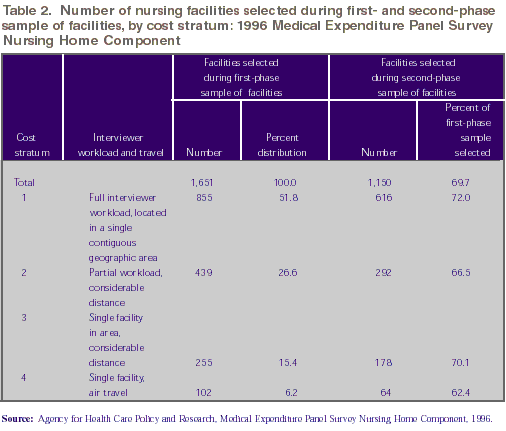
Return To Top
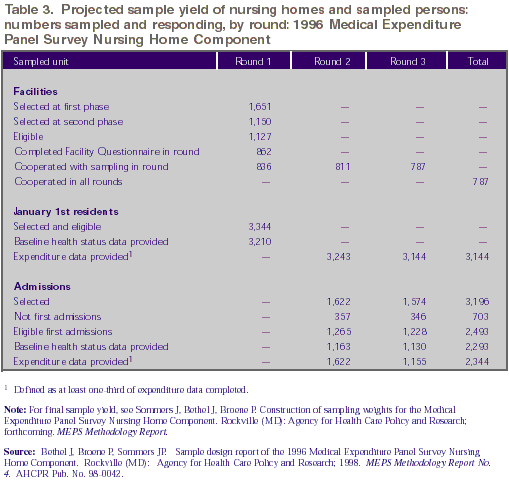
Return To Top

Return To Top

Return To Top
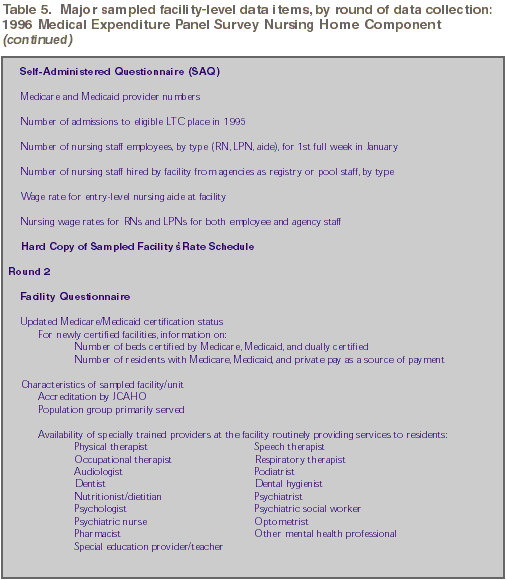
Return To Top
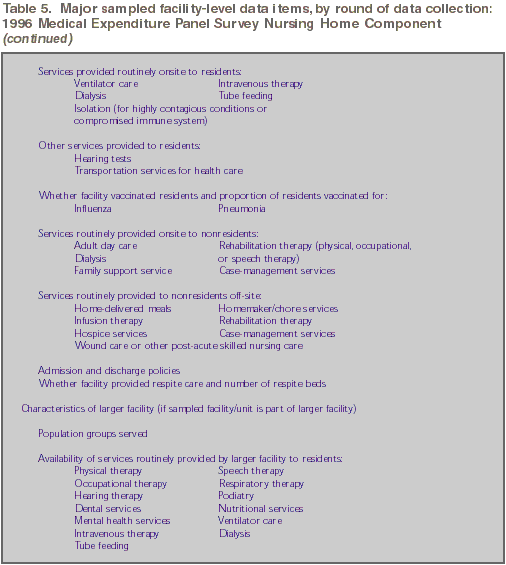
Return To Top
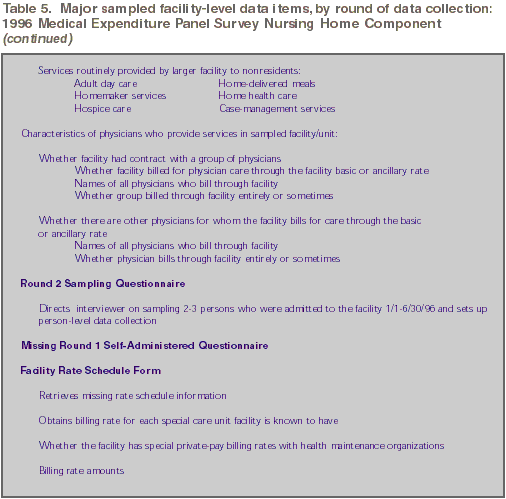
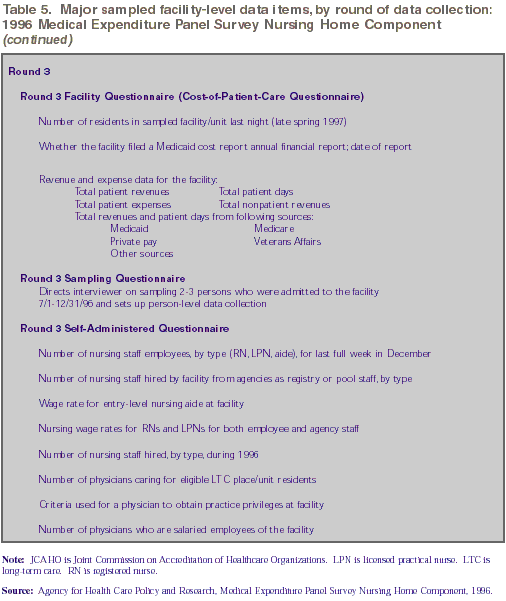
Return To Top

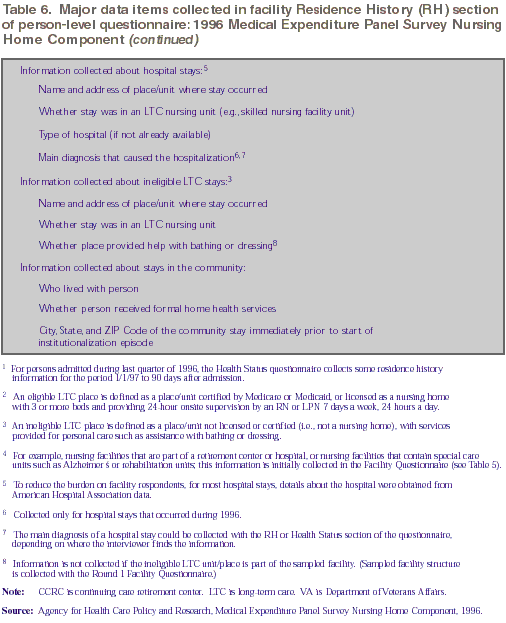
Return To Top
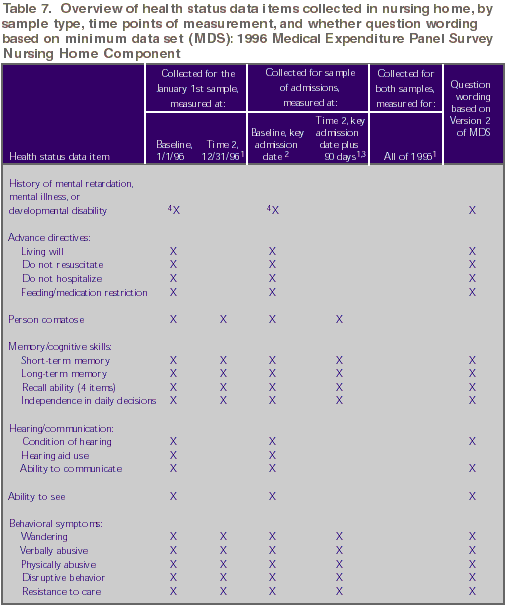
Return To Top
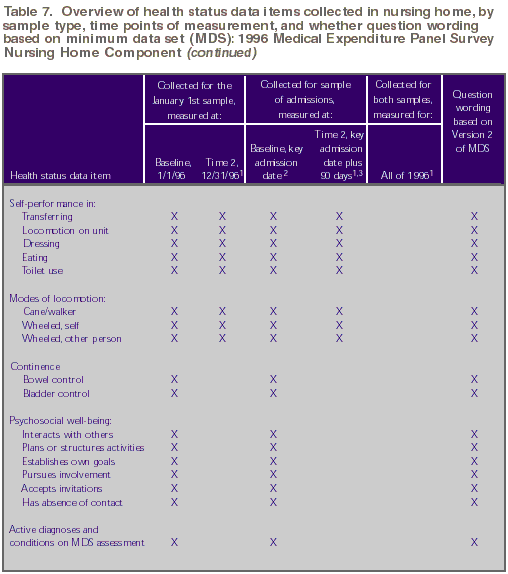
Return To Top

Return To Top
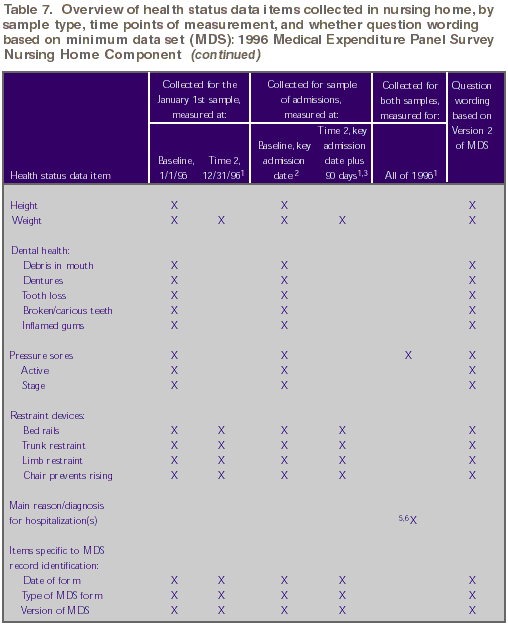
Return To Top
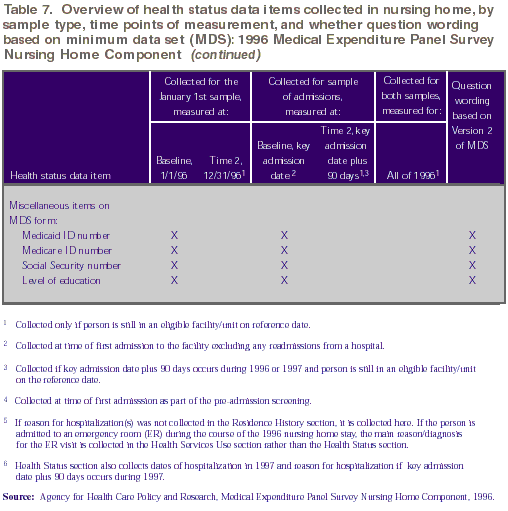
Return To Top
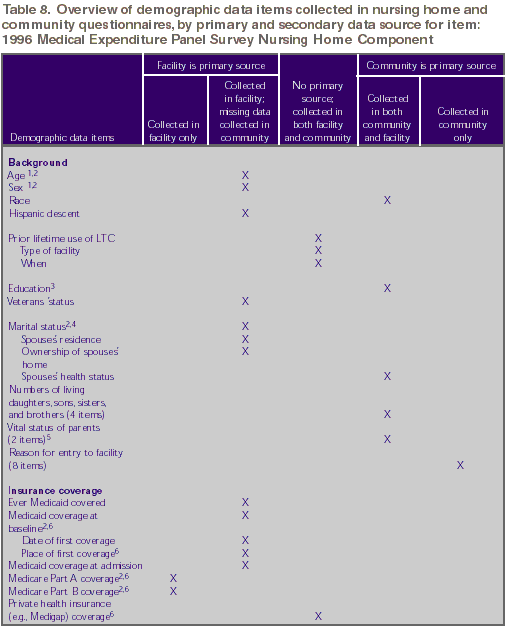
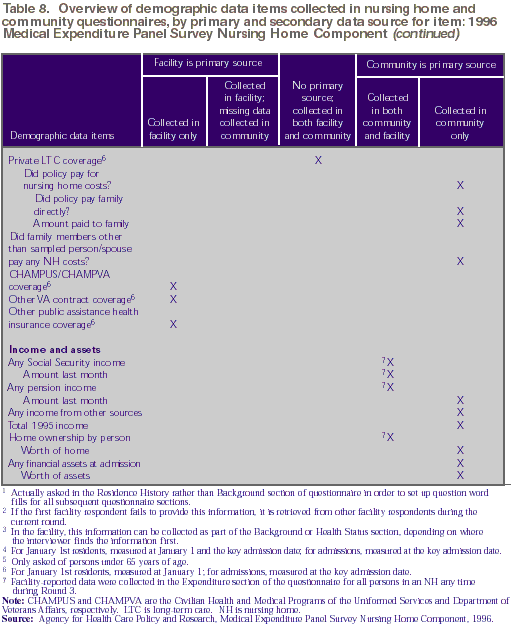
Return To Top
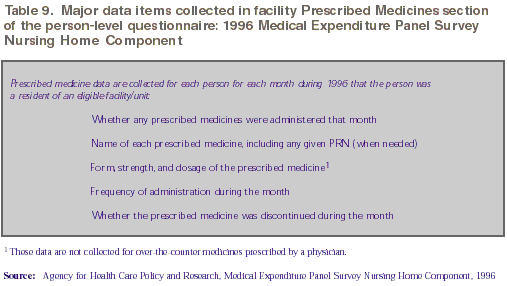
Return To Top
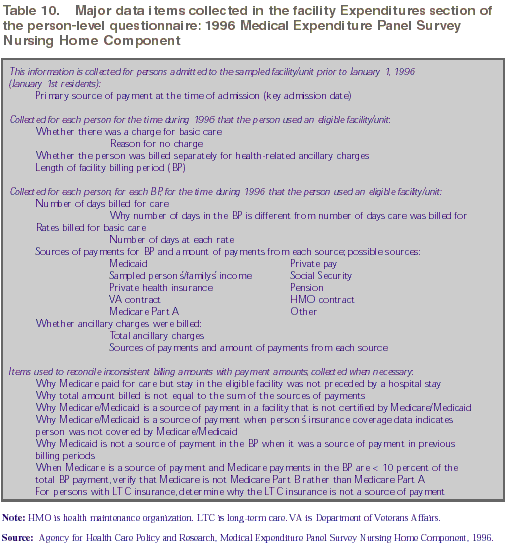
Return To Top
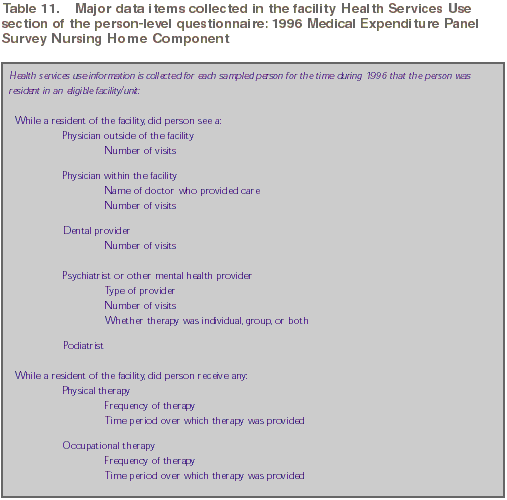
Return To Top
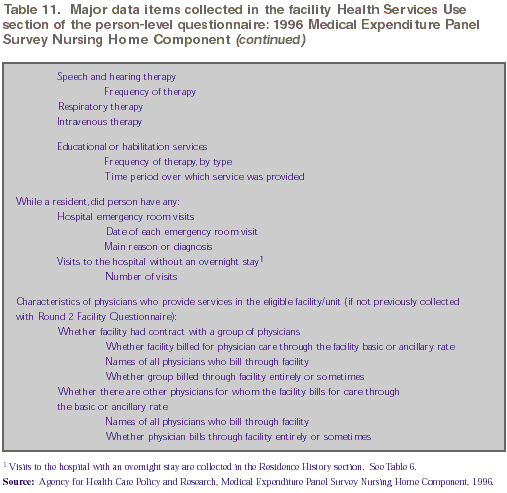
Return To Top
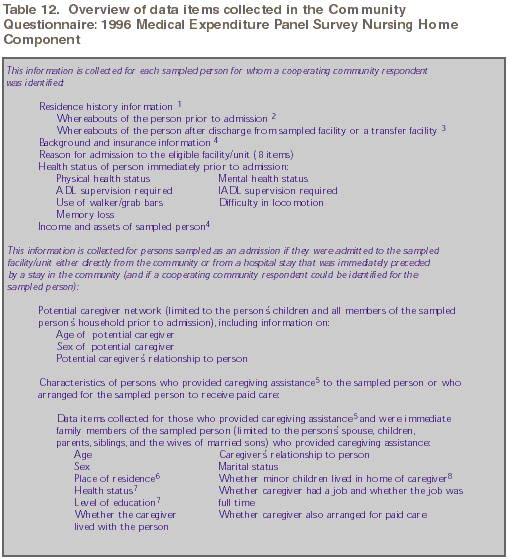
Return To Top
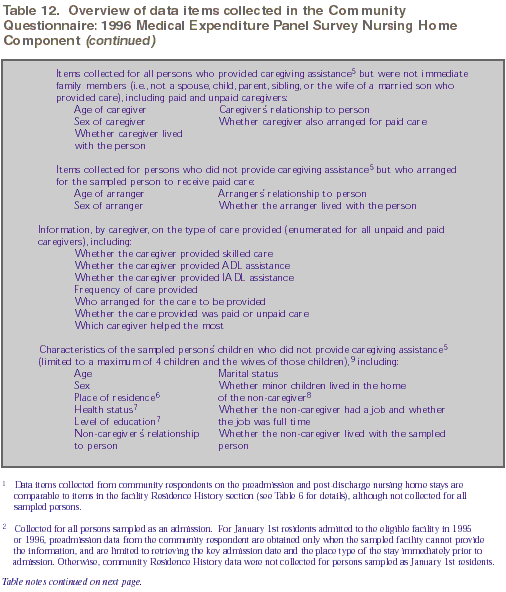
Return To Top
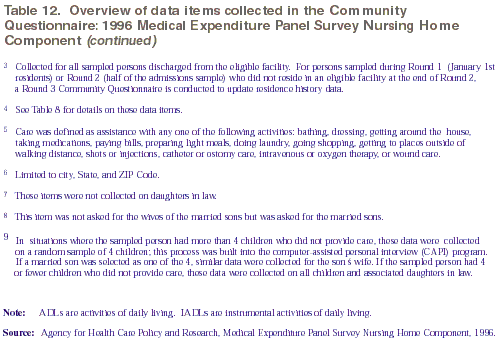

Appendix
List of Acronyms
and Terms Used in This Report and in the MEPS Nursing Home Component
Questionnaires
| ADLs |
Activities of daily living. |
| AHA |
American Hospital Association. The NHC CAPI
application contained a preloaded Hospital Provider Directory
that interviewers used during data collection to obtain address
information on hospitals. The AHA file of hospitals was used
as the source data for the directory. |
| AHCPR |
Agency for Health Care Policy and Research. |
| APHA |
American Public Health Association. |
| B |
Baseline, initial assessment date for the
health status and insurance coverage questions. B was measured
at January 1, 1996, for the January 1st sample and at the key
admission date for persons sampled as an admission. |
| BCAVD |
Closest valid assessment date for baseline
health status data. |
| BP |
Billing period. |
| BQ |
1. Background Questionnaire, also known
as the Facility Background Questionnaire.
2. Used to denote the background history and demographic questions. |
| BRK |
Break-off, a partially completed interview. |
| C |
A questionnaire disposition code indicating
a completed questionnaire. |
| CADE |
Computer-assisted data entry. |
| CAI |
Computer-assisted interview. |
| CAPI |
Computer-assisted personal interview. |
| CCRC |
Continuing care retirement center. |
| CED |
Community end date, the end date of the
most recent time the sampled person lived in the community. |
| CHAMPUS |
Civilian Health and Medical Program of the
Uniformed Services, a health insurance program that covers
both active-duty and retired military personnel, their dependents,
and survivors. |
| CHAMPVA |
Civilian Health and Medical Program of the
Department of Veterans Affairs, a health insurance program
that covers disabled veterans, their dependents, and survivors. |
| COMM |
Community places of residence, one of the
four place type designators used in the MEPS NHC. It includes
all independent living units of retirement centers as well
as private homes or apartments. |
| CPCQ |
Cost-of-Patient-Care Questionnaire, the
Round 3 Sampled Facility Questionnaire. |
| CQ |
1. Community Questionnaire. 2. Used to denote
questions that are asked only of community respondents (e.g.,
caregiving data). |
| CR |
Current residents, sampled persons who were
resident in a sampled NH on January 1, 1996. These persons
were all sampled during Round 1. |
| CRQ |
Consent required, a questionnaire disposition
code indicating that consent of the sampled person's next of
kin was required prior to data collection. |
| CRR |
Community Respondent Roster, a paper questionnaire
used to obtain names and locating information on persons nominated
as potential community respondents for the sampled person. |
| CTRL/A |
A preprogrammed CAPI function key that the
interviewer used to add a new text line to a list of items
(e.g., a roster) displayed by CAPI. |
| CTRL/B |
A preprogrammed CAPI function key that the
interviewer used to navigate the CAPI application backward
one screen at a time. |
| CTRL/D |
A preprogrammed CAPI function key that the
interviewer used to delete a text item from a list of items
displayed by CAPI; typically used to correct an entry. |
| CTRL/E |
A preprogrammed CAPI function key that the
interviewer used to break off an interview for resumption later. |
| CTRL/F |
A preprogrammed CAPI function key that the
interviewer used to navigate the CAPI application forward one
screen at a time within an episode of backward movement. |
| CTRL/G |
A preprogrammed CAPI function key that the
interviewer used to "fast forward" the CAPI application
to the next field with no data entry. |
| CTRL/J |
A preprogrammed CAPI function key that the
interviewer used to open a "jumpback" menu window;
used to navigate the application backward across multiple screens
simultaneously. |
| CTRL/K |
A preprogrammed CAPI function key that the
interviewer used to open a comment window. |
| CVAD |
Closest valid assessment date for health
status items. For January 1st residents, measured at January
1 and December 31, 1996. For persons sampled as admissions,
measured at the key admission date and 90 days after the key
admission date. Some health status items are also measured
across all of 1996. |
| DE |
Data entry. |
| DHHS |
Department of Health and Human Services. |
| DK |
Don't know, indicated in the public use
database as a "-8". |
| DOA |
Dead on arrival. |
| DOB |
Date of birth. |
| DOD |
Date of death. |
| DOI |
Date of interview. |
| DON |
Director of Nursing. |
| Dx |
Diagnosis. |
| EF |
Eligibility code used to identify an eligible
first admission. |
| ELIG LTC |
Eligible long-term care place, one of the
four place type designators used in the MEPS NHC. It is defined
as a facility or distinct part of a facility certified by Medicare
as a skilled nursing facility or by Medicaid as a nursing facility,
or licensed as a nursing home with three or more beds that
provides onsite supervision by an RN or LPN 7 days a week,
24 hours a day. |
| ER |
Emergency room. |
| EX |
1. Expenditure Questionnaire. 2. Used to
denote questions on NH expenditures and sources of payment. |
| F2 |
A sampled person whose first admission to
the sampled nursing home in 1996 was on or between 1/1/96 and
6/30/96; a person sampled as a first admission during Round
2. |
| F3 |
A sampled person whose first admission to
the sampled nursing home in 1996 was on or between 7/1/96 and
12/31/96; a person sampled as a first admission during Round
3. |
| FA |
1. First admission, sampled person admitted
to the sampled nursing home during 1996 on January 1 or later
who had no earlier admission to any eligible nursing home (F2
and F3).
2. Denotes questions in the Round 1 Facility Questionnaire on the structure
and basic characteristics of the NH. |
| Face sheet |
Document used by the interviewing staff
to manage their interviewing assignments. |
| FACILITY |
A nursing home, used to denote the NH where
data collection is occurring or to indicate data collected
from NH sources. |
| FB |
Identifies facility-level questions on the
services provided by the nursing home. |
| FC |
1. Identifies questions in the Round 3 Sampled
Facility Questionnaires on cost of patient care and NH revenues.
2. Facility complete, a questionnaire disposition code. |
| FCD |
Final consent denied, a questionnaire disposition
code. |
| FG |
Facility Records Organizational Grid, a
form used by the interviewers to determine the best NH respondents,
by type of information to be collected. Also know as the FROG. |
| FLU |
Year of first (lifetime) long-term care
use. |
| FQ |
Facility Questionnaire. An FQ is administered
within sampled and transfer nursing homes each round and is
used to collect facility-level information about the nursing
home. |
| FR |
1. Facility Rate Schedule, information obtained
from the NH (usually as a printed document) on the rates charged
NH residents. Also known as FRS. 2. Used to denote items associated
with the retrieval of the NH's rate schedule. 3. Final refusal,
a questionnaire disposition code. |
| FROG |
Facility Records Organizational Grid; see
FG. |
| FRS |
Facility Rate Schedule; see FR. |
| FTE |
Full-time equivalent (employee). |
| HA |
Used to denote the Health Status questions
that measure health status at a point in time (e.g., Baseline
and Time 2). |
| HB |
Used to denote the Health Status questions
that measure health status across time (e.g., all of 1996 while
an NH resident). |
| HC |
Used to denote questions concerning the
data collection method used to collect health status data in
the NH. |
| HCFA |
Health Care Financing Administration. |
| HMO |
Health maintenance organization. |
| HOSP |
Hospital, one of the four place type designators
used in the MEPS NHC, included acute or long-term care hospitals.
In the case of a hospital with a skilled nursing unit or an
eligible long-term care unit, the SNF/LTC unit was classified
as an eligible LTC place and the remaining hospital units were
classified as appropriate (e.g., hospital). |
| HS |
Health Status Questionnaire administered
in the NH. |
| IA |
1. Income and Assets Questionnaire. 2. Used
to denote questions on income and assets. |
| IAD |
Inscope admission date, the beginning of
the episode of eligible nursing home care; the date of the
first admission to the sampled facility, excluding re-admissions
following an acute hospital stay. |
| IADLs |
Instrumental activities of daily living. |
| ICD |
Initial consent denied, a questionnaire
disposition code. |
| ICF |
Intermediate care facility. |
| IF |
First-admission eligibility code used to
denote an ineligible first admission. |
| IN |
1. Insurance Questionnaire, also known as
the Facility Health Insurance Questionnaire. 2. Used to denote
the health insurance coverage questions. |
| INEL LTC |
Ineligible long-term care place, one of
the four place type designators used in the MEPS NHC. It is
defined as a facility or distinct part of a facility that is
not certified or licensed as an eligible nursing home but provides
services for personal care assistance with dressing or bathing. |
| INMD |
Insurance Questionnaire Missing Data Module.
If the initial NH respondent was unable to provide the interviewer
with data on a sampled person's Medicare and Medicaid coverage,
these questions were re-asked of alternative NH respondents
in an attempt to acquire complete information on Medicare and
Medicaid coverage. |
| IPC |
Institutional Population Component of the
1987 National Medical Expenditure Survey. |
| January 1st residents |
The cross-sectional sample of persons who
were resident in the NH on January 1, 1996; also known as "current
residents." |
| JCAHO |
Joint Commission on Accreditation of Healthcare
Organizations. |
| KAD |
Key admission date, the beginning of the
episode of sampled nursing home care; the date of the first
admission to the sampled facility, excluding readmission following
an acute hospital stay. |
| KAD unit |
The unit within the sampled NH where the
sampled person resided at the key admission date. |
| Keyfitz procedure |
A statistical method for improving the efficiency
of sample selection. |
| Larger facility |
Some nursing homes are part of a larger
organizational or physical structure, such as a continuing
care retirement center or a hospital. In these cases, the larger
structure (provided it is on the same campus as the NH) is
referred to as the "larger facility." |
| LPN |
Licensed practical nurse. |
| LTC |
Long-term care. An LTC place is defined
as a place or distinct unit that provides a residence and some
surveillance and has assistance available for persons no longer
willing or able to live on their own. This includes the following
types of places: nursing home, SNF unit of a hospital or retirement
center, residential care facility, assisted living facility,
board and care home, domiciliary care home, personal care home,
rest home, shelter care facility, community living facility,
community residential alternative group home for the mentally
disabled, group senior assisted housing for the elderly, group
care home, adult group home, foster care home, VA home for
adults, hospital for the mentally ill or mentally retarded.
Long-term care places/units in the MEPS NHC are further classified
as either "eligible LTC" (e.g., a nursing home) or "ineligible
LTC" (e.g., a personal care unit). |
| MD |
Missing data or Missing Data Module. If
the initial NH respondent was unable to provide the interviewer
with a key data item (e.g., sex, age, Medicaid insurance coverage,
sources of payment), the question (i.e., the missing data item)
was re-asked of alternative NH respondents in an attempt to
acquire complete information. The key items for which missing
data activities were conducted are specified as part of the
various CAPI questionnaires in the Missing Data Module section
of each questionnaire. Not all questionnaires have a Missing
Data Module. |
| MDS |
Minimum data set. |
| MEPS |
Medical Expenditure Panel Survey. |
| NA |
Item not applicable due to a skip pattern,
indicated in the public use database as a "-1". |
| NCHS |
National Center for Health Statistics. |
| NF |
1. Medicaid certified nursing facility.
2. A new facility, an eligible nursing home (sampled or otherwise)
into which a sampled person transferred during 1996; also known
as a transfer facility. |
| NH |
Nursing home, an eligible long-term care
place, defined as a facility or distinct part of a facility
certified by Medicare or Medicaid or licensed as a nursing
home with three or more beds that provides onsite supervision
by an RN or LPN 7 days a week, 24 hours a day. |
| NHC |
Nursing Home Component of the 1996 Medical
Expenditure Panel Survey. |
| NHPI |
National Health Provider Inventory; an updated
NHPI served as the sampling frame for the MEPS NHC. To assist
in data collection, the sampling frame was preloaded onto each
interviewer's laptop computer and used to identify eligible
LTC facilities. |
| NMCES |
1977 National Medical Care Expenditure Survey. |
| NMES |
1987 National Medical Expenditure Survey. |
| NMES-2 |
Alternative name for the 1987 National Medical
Expenditure Survey. |
| NMES-3 |
Name previously given to the 1996 Medical
Expenditure Panel Survey. |
| NNHES |
National Nursing Home Expenditure Survey,
name previously given to the 1996 Medical Expenditure Panel
Survey Nursing Home Component. |
| NNHS |
National Nursing Home Survey, a periodic
survey conducted by the National Center for Health Statistics. |
| NOK |
Next of kin of the sampled person, the typical
respondent for the Community Questionnaire. |
| Non-nursing beds |
Beds that are not certified or licensed
to provide residents the level of skilled nursing care, rehabilitation
services, or other health-related services that is provided
in nursing beds (i.e., beds in an INEL LTC unit). |
| Nursing beds |
Beds that are certified or licensed to provide
residents the same level of skilled nursing care, rehabilitation
services, or other health-related services that is provided
in nursing beds (i.e., beds in an ELIG LTC unit). |
| Offsite |
Outside the premises of the nursing home
or facility. |
| Onsite |
On the premises of the nursing home or facility. |
| OTC |
Over-the-counter, medications available
without a prescription. |
| PF |
First admission eligibility code used to
identify a provisionally eligible first admission. All persons
initially classified as PF were eventually classified as eligible
or ineligible as additional data became available. |
| Place roster |
A listing of all places enumerated during
data collection. The place roster is unique for each participating
NH and lists all units within the NH and parts of the larger
facility (if the NH is part of a larger facility), as well
as hospitals, other LTC places, and community residences ascertained
during facility-level and person-level data collection in a
nursing home. |
| PM |
1. Prescribed Medicines Questionnaire. 2.
Used to denote the questions on prescribed medicines administered
in the NH. |
| PRN |
Standing order, administer as necessary. |
| QR |
Questionnaire respondent. |
| QxQ |
Question-by-question specifications; QxQ's
provide item-specific information to interviewers on the intent
of question wording. In the MEPS NHC these were provided online
as part of the CAPI questionnaires. |
| R1 (R2 and R3) |
The first round (second round and third
round) of data collection. |
| RDY |
Ready for interviewing, a questionnaire
disposition code. |
| Red Book File |
A standard reference of the pharmacy industry
that contains detailed information on all medications sold
in the United States. |
| REF |
1. Final refusal, a questionnaire disposition
code. 2. An item refused by a respondent, indicated in the
public use database as a "-7". |
| REF DATE |
Reference date. The reference date for the
MEPS NHC is calendar year 1996. The reference date for a particular
person, particular nursing home, or specific questionnaire
or question item can vary depending on, among other things,
the round of data collection, kind of information to be collected,
when the sampled person was sampled, when data collection was
initiated in the nursing home, and the current and past location(s)
of a sampled person. Questionnaire reference dates can be a
point in time or for periods of time. (See this report for
details and the MEPS NHC questionnaires for complete reference
date specifications.) |
Respondent
roster |
A facility-level online directory that contains
the names, title, and locating information of all potential
respondents and all actual respondents within an NH. Questions
denoted "RR" indicate items about the questionnaire
respondents. |
| RF |
Refused; see REF. |
| RH |
1. Residence History Questionnaire. 2. Used
to denote person-level questions on residence history. |
| RN |
Registered nurse. |
| ROC |
Record of calls, used by the interviewers
to document all contacts with the nursing homes and community
respondents. |
| RR |
Respondent roster; see Respondent roster. |
| RRB |
Railroad Retirement Board. |
| SAD |
Sampled admission date. For January 1st
residents, the date of the most recent admission to the sampled
facility prior to January 1, 1996. For persons sampled as first
admissions, the date of the first admission to the sampled
facility during the reference year (January 1 to December 31,
1996). |
| SAD unit |
The unit within the sampled NH where the
sampled person resided at the sampled admission date. |
| SAQ |
1. Self-Administered Questionnaire; a SAQ,
distributed to nursing home respondents during Rounds 1 and
3, collected facility-level staffing information. 2. Used to
denote questions from the Self-Administered Questionnaires. |
| SE |
First admission eligibility code assigned
by the CAPI program to indicate that the sampled person was
sampled by the interviewer in error. |
| SF |
Sampled facility, one of the sampled nursing
homes. |
| SHIFT/5 |
A CAPI function key used to indicate that
the respondent "will never know" the information
asked for. Denoted in the public use database as a "-5". |
| SNF |
Medicare skilled nursing facility. |
| SOP |
Source of payment. |
| SP |
Sampled person. |
| SS |
Sampling section, used to denote the question
items in the Facility Questionnaire on the sampling of persons
within a sampled NH. |
| SSA |
Social Security Administration. |
| SSDI |
Social Security Disability Income. |
| SSI |
Supplemental Security Income. |
| SSN |
Social Security Number. |
| T2 |
Time 2, the second assessment point for
cross-sectional health status data. It is collected only when
the sampled person was a resident of a nursing home at Time
2 point. For January 1st residents, Time 2 is measured at December
31, 1996; for admissions, it is measured at the key admission
date plus 90 days. |
| TAD |
Transfer admission date, the date of admission
to the eligible facility, either sampled or new, by a sampled
person who transfers out of the originally sampled NH to another
NH during the reference year (as reported by the transfer facility). |
| TAD unit |
The unit within the transfer facility where
the sampled person resided at the time of admission to the
transfer facility. |
| TCVAD |
Closest valid assessment date for Time 2
health status data; see T2. |
| Tentative additions |
An interim disposition regarding the eligibility
of a unit within the nursing home or within the larger facility
(if the NH is part of a larger facility). All units are eventually
classified into one of the four place type designators (e.g.,
eligible LTC, ineligible LTC). |
| TIME 2 |
See T2. |
| TR |
Transferred person, used to designate a
sampled person within a new facility. These persons were discharged
from their sampled nursing home during 1996 and were subsequently
admitted to another NH (either a sampled NH or some other NH). |
| URI |
Upper respiratory infection. |
| US |
Used to denote questions from the Use of
Health Care Services Questionnaire. |
| USE |
Use of Health Care Services Questionnaire. |
| VA |
Veterans Affairs (Department of). |
Return To Top
Suggested Citation:
Methodology Report #3: Design and Methods of the 1996 MEPS Nursing Home Component. September 1998.
Agency for Health Care Policy and Research,
Rockville, MD.
http://www.meps.ahrq.gov/data_files/publications/mr3/mr3.shtml
|
|
